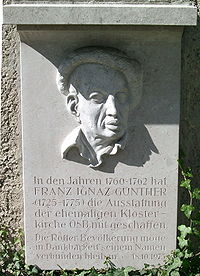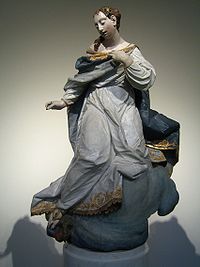
Ignaz Günther
Encyclopedia


Woodworking
Woodworking is the process of building, making or carving something using wood.-History:Along with stone, mud, and animal parts, wood was one of the first materials worked by early humans. Microwear analysis of the Mousterian stone tools used by the Neanderthals show that many were used to work wood...
working in the Bavaria
Bavaria
Bavaria, formally the Free State of Bavaria is a state of Germany, located in the southeast of Germany. With an area of , it is the largest state by area, forming almost 20% of the total land area of Germany...
n rococo
Rococo
Rococo , also referred to as "Late Baroque", is an 18th-century style which developed as Baroque artists gave up their symmetry and became increasingly ornate, florid, and playful...
tradition.
He was born in Altmannstein
Altmannstein
Altmannstein is a municipality in the district of Eichstätt in Bavaria in Germany....
, Germany
Germany
Germany , officially the Federal Republic of Germany , is a federal parliamentary republic in Europe. The country consists of 16 states while the capital and largest city is Berlin. Germany covers an area of 357,021 km2 and has a largely temperate seasonal climate...
, where he received his earliest training from his father, then studied in Munich
Munich
Munich The city's motto is "" . Before 2006, it was "Weltstadt mit Herz" . Its native name, , is derived from the Old High German Munichen, meaning "by the monks' place". The city's name derives from the monks of the Benedictine order who founded the city; hence the monk depicted on the city's coat...
under the court sculptor Johann Baptist Straub
Johann Baptist Straub
Johann Baptist Straub was a German Rococo sculptor.-Biography:Straub was born in Wiesensteig, into a family of sculptors. His father Johann George Straub and his brothers Philipp Jakob, Joseph, and Johann Georg Straub were also sculptors, as was his nephew Franz Xaver Messerschmidt. J. B...
from 1743 to 1750 and during his Wanderjahren that also took him to Salzburg, Olmütz, and Vienna, under Paul Egell in Mannheim
Mannheim
Mannheim is a city in southwestern Germany. With about 315,000 inhabitants, Mannheim is the second-largest city in the Bundesland of Baden-Württemberg, following the capital city of Stuttgart....
from 1751 t 1752. Between May and October 1753, he worked at the Vienna Academy of Fine Arts
Academy of Fine Arts Vienna
The Academy of Fine Arts Vienna is an institution of higher education in Vienna, Austria.- History :The Academy of Fine Arts Vienna was founded in 1692 as a private academy by the court-painter Peter Strudl, who became the Praefectus Academiae Nostrae. In 1701 he was ennobled as Baron of the Empire...
and won the annual students' competition. In 1754, he started his own workshop in Munich
Munich
Munich The city's motto is "" . Before 2006, it was "Weltstadt mit Herz" . Its native name, , is derived from the Old High German Munichen, meaning "by the monks' place". The city's name derives from the monks of the Benedictine order who founded the city; hence the monk depicted on the city's coat...
, where he died.
He is best remembered for his work in churches, especially his altars.
Major works
- AltmannsteinAltmannsteinAltmannstein is a municipality in the district of Eichstätt in Bavaria in Germany....
—Church of the Holy Cross (1763–1764) - Aschau im ChiemgauAschau im ChiemgauAschau im Chiemgau is a municipality in the district of Rosenheim in Bavaria in Germany....
—Gallery of Ancestors in Burg Hohenaschau (two wooden statues) (1766) - BenediktbeuernBenediktbeuernBenediktbeuern is a municipality in the district of Bad Tölz-Wolfratshausen in Bavaria, Germany. The distance between Bichl and Benediktbeuern is only 2 kilometers, or 1.25 miles. The village has about 3,500 residents as of 2004....
—Church of St. BenedictBenediktbeuern AbbeyBenediktbeuern Abbey is a monastery of the Salesians of Don Bosco, originally a monastery of the Benedictine Order, in Benediktbeuern in Bavaria, near the Kochelsee, 64 km south-south-west of Munich...
(side altars, attributed) - FreisingFreisingFreising is a town in Bavaria, Germany, and capital of the district Freising. Total population 48,500.The city is located north of Munich at the Isar river, near the Munich International Airport...
—Neustift Abbey Church (high altar) (1756) - Gmund am TegernseeGmund am TegernseeGmund am Tegernsee is a municipality in the district of Miesbach in Bavaria in Germany. The town is located on the north shore of the Tegernsee Lake, and near the source of River Mangfall...
—Parish Church of St. Ägidius (gilded wooden relief on north side altar) (1763) - Greisstätt-AltenhohenauWasserburg am InnWasserburg am Inn is a town in the district Rosenheim in Upper Bavaria, Germany. The historic centre is a peninsula, formed by the meandering Inn River...
—Monastery Church of St. Peter and St. Paul (altars) (1767) - IngolstadtIngolstadtIngolstadt is a city in the Free State of Bavaria, in the Federal Republic of Germany. It is located along the banks of the Danube River, in the center of Bavaria. As at 31 March 2011, Ingolstadt had 125.407 residents...
—Minorite Church (Preysing epitaphEpitaphAn epitaph is a short text honoring a deceased person, strictly speaking that is inscribed on their tombstone or plaque, but also used figuratively. Some are specified by the dead person beforehand, others chosen by those responsible for the burial...
) (1770) - Mallersdorf—Mallersdorf AbbeyMallersdorf AbbeyMallersdorf Abbey was formerly a monastery of the Benedictine Order and is now a Franciscan convent in Mallersdorf-Pfaffenberg in Bavaria.-History:...
(high altar) (1768–1770) - MunichMunichMunich The city's motto is "" . Before 2006, it was "Weltstadt mit Herz" . Its native name, , is derived from the Old High German Munichen, meaning "by the monks' place". The city's name derives from the monks of the Benedictine order who founded the city; hence the monk depicted on the city's coat...
—BürgersaalkircheBürgersaalkirche (Munich)The Bürgersaal is a historical building in Munich, Germany. Also known as Bürgersaalkirche since the consecration of the altar on May 13, 1778, it is the prayer and meeting room of the Marian Men Congregation "Annunciation". It was built in 1709/1710 under design by Giovanni Antonio Viscardi...
(guardian angels under the organ gallery) (1762) - MunichMunichMunich The city's motto is "" . Before 2006, it was "Weltstadt mit Herz" . Its native name, , is derived from the Old High German Munichen, meaning "by the monks' place". The city's name derives from the monks of the Benedictine order who founded the city; hence the monk depicted on the city's coat...
—Pieces in the Bavarian National MuseumBavarian National MuseumThe Bavarian National Museum in Munich is one of the most important cultural history museums in Europe.-Building and History:...
, including his Hausmadonna for private devotion - München-HarlachingBoroughs of MunichSince the administrative reform in 1992, Munich is divided into 25 boroughs or Stadtbezirke:-References:Source:...
—Pilgrimage Church of St. Anna (altars) (1763&1764) - NenningenLautersteinLauterstein is a town in the district of Göppingen in Baden-Württemberg in southern Germany. It is located 15 km east of Göppingen, and 11 km southeast of Schwäbisch Gmünd....
—Cemetery Chapel (PietàPietàThe Pietà is a subject in Christian art depicting the Virgin Mary cradling the dead body of Jesus, most often found in sculpture. As such, it is a particular form of the Lamentation of Christ, a scene from the Passion of Christ found in cycles of the Life of Christ...
—last known work of Günther) (1774) - Rott am InnRott am InnRott am Inn is a municipality in the district of Rosenheim in Bavaria in Germany....
—Benedictine Abbey Church of St. Marinus and St. Anianus)Rott AbbeyRott Abbey was a Benedictine monastery in Rott am Inn in Bavaria, Germany.-History:The monastery, dedicated to Saints Marinus and Anianus, was founded by Count Kuno of Rott ....
(high altar, side altars, and figures of the TrinityTrinityThe Christian doctrine of the Trinity defines God as three divine persons : the Father, the Son , and the Holy Spirit. The three persons are distinct yet coexist in unity, and are co-equal, co-eternal and consubstantial . Put another way, the three persons of the Trinity are of one being...
, Saint Kunigunde, Saint HenryHenry II, Holy Roman EmperorHenry II , also referred to as Saint Henry, Obl.S.B., was the fifth and last Holy Roman Emperor of the Ottonian dynasty, from his coronation in Rome in 1014 until his death a decade later. He was crowned King of the Germans in 1002 and King of Italy in 1004...
, Saint CorbinianCorbinianSaint Corbinian was a Frankish bishop. His feast day is September 8. The commemoration of the translation of his relics is November 20.-Life:...
and Saint UlrichUlrich of AugsburgSaint Ulrich , sometimes spelled Uodalric or Odalrici, was Bishop of Augsburg and a leader of the Roman Catholic Church in Germany. He was the first saint to be canonized.-Family:...
) (1761–1762) - StarnbergStarnbergThe city of Starnberg is in Bavaria, Germany, some 30 km south-west of Munich. It lies at the north end of Lake Starnberg, in the heart of the "Five Lakes Country", and serves as capital of the district of Starnberg...
—St. Joseph's Church (high altar) (1766–1768) - WeyarnWeyarnWeyarn is a municipality in the district of Miesbach in Bavaria in Germany. It dates back to a monastery that was founded by Siboto II, count of Falkenstein in 1133. It is located 38 km southeast of Munich and can be easily reached on highway A8 running from Munich to Salzburg. Many farming...
—Catholic Parish Church of St. Peter and St. Paul (woodcarving on high altar, including AnnunciationAnnunciationThe Annunciation, also referred to as the Annunciation to the Blessed Virgin Mary or Annunciation of the Lord, is the Christian celebration of the announcement by the angel Gabriel to Virgin Mary, that she would conceive and become the mother of Jesus the Son of God. Gabriel told Mary to name her...
, PietàPietàThe Pietà is a subject in Christian art depicting the Virgin Mary cradling the dead body of Jesus, most often found in sculpture. As such, it is a particular form of the Lamentation of Christ, a scene from the Passion of Christ found in cycles of the Life of Christ...
, puttiPuttoA putto is a figure of an infant often depicted as a young male. Putti are defined as chubby, winged or wingless, male child figure in nude. Putti are distinct from cherubim, but some English-speakers confuse them with each other, except that in the plural, "the Cherubim" refers to the biblical...
, the carved shrine of Saint ValeriusValerius of TrèvesSaint Valerius was a semi-legendary bishop of Trier. His feast day is 29 January.-Legend:According to an ancient legend, he was a follower of Saint Eucharius, the first bishop of Trier...
, and silver-framed tabernacleChurch tabernacleA tabernacle is the fixed, locked box in which, in some Christian churches, the Eucharist is "reserved" . A less obvious container, set into the wall, is called an aumbry....
) (1763–1764)

